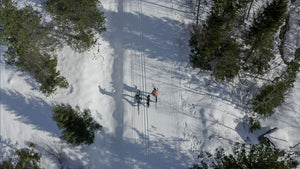Through hard work comes happiness and the importance of recovery
Jan 25, 2024
Mimmi gives us her view on what we in Sweden calls the ox-weeks. Some great learnings on the importance of recovery and of course an update on what is going on at Moonvalley and in the lives of the founders.
----
Hope you are all settling into the new year. As dark and cold as the season might seem, this is actually one of my favorite times. In Sweden, this time of year, from Epiphany and 2 months on, is referred to as the ox-weeks. Never-ending hard work, the middle of winter, no holidays or festivities, dark and cold. I love this ox metaphor and embrace the dark and strife. Now is the time for putting your head down, getting the work done, eating your veggies, and going to bed early. Just chipping away at whatever your project is so that when spring arrives, you are ready. It is perhaps not the most cheerful time of year, but I would choose the more humble feeling of content over happiness any day. Content does not thrive on festivities and highs; it thrives on hard work.
--
So, what are we up to at Moonvalley?
Well, for me, I am still rehabilitating a knee injury that seems to be dragging on forever. This means that the normal big training on skis is not happening this winter. Instead, I spend a lot of time in the gym building my strength and functionality back up. We also got a new little family member, little Bruno the Dog, so keeping busy is no problem. He is a delight, but pups are crazy…
Emelie and Ida are chipping away in Måndalen, mainly doing ski mountaineering this time of year. Ski mountaineering requires a unique blend of cardiovascular endurance, strength, and technical skill. It is easy on the joints and such good cross-training for a trail runner!
The Importance of Recovery
Putting in big volume in winter training puts a great demand on your body, so a focus on recovery is key to soak up all those training gains and avoid injuries, illness, and fatigue. In the spirit of this, the three cornerstones of recovery are always good to keep in mind:
Nutrition
Ski mountaineers expend a considerable amount of energy during training, depleting glycogen stores and causing muscle breakdown. Proper refueling with a balanced combination of carbohydrates, protein, and fats is essential for replenishing energy stores, repairing muscle tissue, and supporting overall recovery. Post-workout nutrition is a key aspect of the recovery process here. Consuming a combination of carbohydrates and protein within the first 30 minutes to an hour after training helps replenish glycogen stores and kickstart muscle repair.
Hydration
Staying on top of hydration is important. Sometimes it is hard to tune into the body's thirst signals in cold conditions, but maintaining optimal hydration levels is important. Dehydration can impair cognitive function, increase the risk of injuries, and delay the recovery process. Ski mountaineers need to prioritize hydration before, during, and after workouts, considering the challenges of training in cold environments.
Sleep
Quality sleep is a non-negotiable component of recovery. During sleep, the body is doing the actual work of building the body back up: hormone regulation, muscle repair, and memory consolidation. So prioritizing consistent and adequate sleep is paramount.
There you go: train, eat, sleep, repeat. And embrace the grind!
Love from us at Moonvalley ❤️


